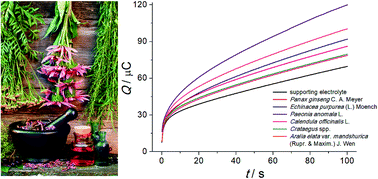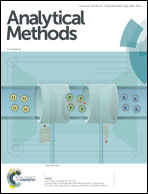Chronocoulometric method for the evaluation of antioxidant capacity of medicinal plant tinctures†
Abstract
The oxidation potentials of medicinal plant tinctures have been studied on glassy carbon electrode, modified layer-by-layer with multi-walled carbon nanotubes and poly(gallic acid) (PGA/MWNT/GCE) in phosphate buffer solution of pH 7.4. PGA-modified electrode has shown significantly higher sensitivity towards antioxidants in tinctures in comparison to bare GCE and MWNT/GCE. A novel approach for the evaluation of antioxidant capacity of medicinal plant tinctures using one-step chronocoulometry at 1.0 V has been developed. A steady state is achieved at 100 s of electrolysis. The antioxidant capacity has been expressed in quercetin equivalents per 1 mL of tincture. Linear dynamic ranges of 0.010–0.25 and 0.25–250 μmol L−1 quercetin with the limits of detection and determination of 2.9 and 9.8 nmol L−1, respectively, have been obtained. Eleven medicinal plant tinctures have been investigated. The antioxidant capacity decreases in the following order: Rhodiola rosea L. > Paeonia anomala L. > Aralia elata var. mandshurica (Rupr. & Maxim.) J. Wen > Echinacea purpurea (L.) Moench ≈ Schisandra chinensis (Turcz.) Baill. > Valeriana officinalis L. ≈ Leonurus cardiaca L. > Mentha piperita L. > Calendula officinalis L. > Crataegus spp. > Panax ginseng C. A. Meyer. Strong positive correlations of the antioxidant capacity of tinctures with the antioxidant activity and total phenolics (r = 0.9715 and 0.9738, respectively, at rcrit = 0.602, α = 0.05 and n = 11) confirm the accuracy of the developed chronocoulometric method.

- This article is part of the themed collection: Analytical Methods Recent HOT articles


 Please wait while we load your content...
Please wait while we load your content...